Common menu bar links
Fact sheet: Family homicides
Archived Content
Information identified as archived is provided for reference, research or recordkeeping purposes. It is not subject to the Government of Canada Web Standards and has not been altered or updated since it was archived. Please "contact us" to request a format other than those available.
The following section examines spousal homicides and homicides committed by family members against children and youth, and older adults (age 65 years and older).
The annual Homicide survey, administered by the Canadian Centre for Justice Statistics (CCJS), collects detailed police-reported information on all homicides that occur in Canada. The term ‘homicide’ throughout this section includes the following Criminal Code offences: 1st degree murder, 2nd degree murder, manslaughter and infanticide.
Spousal homicides
According to the Homicide survey, spousal homicides1 represented 17% of all solved2 homicides in Canada, and nearly half (47%) of all family homicides in 2006. Overall, rates of spousal homicides for both male and female victims have been declining over the last 30 years (1977 to 2006) following the pattern of homicide overall (Chart 4.1).
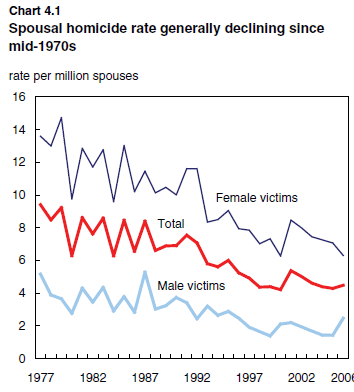
Notes: Spouses include legally married, common-law, separated, and divorced persons age 15 years or older. Excludes same-sex spouses.
Source: Statistics Canada, Canadian Centre for Justice Statistics, Homicide Survey.
Women are more likely than men to be victims of spousal homicide. The rate of spousal homicide against females has been between 3 and 5 times higher than the rate for males during the 30-year period from 1977 to 2006. It is important to note that 2006 saw an increase in the rate for male spousal victims (Table 4.1).
Spousal homicide most often involved common-law partners
Between 1997 and 2006, 39% of spousal homicides involved victims living in common-law relationships (including same-sex couples), accounting for the largest proportion of spousal homicides. However, common-law couples comprised just 16% of spousal relationships in 2006 (Statistics Canada, 2007). Approximately one-third (36%) of spousal homicides occurred between married persons, followed by those who were separated (23%) or divorced (2%) (Table 4.2).
Rates of spousal homicide are highest for young adults, especially for female victims. Between 1997 and 2006, the rate of young women (aged 15 to 24) killed by their spouse was nearly 3 times higher than all female victims of spousal homicide (20 compared to the overall rate of 7 per million female spouses). Similarly, the rate of young males (aged 15 to 24) killed by their spouse was more than 4 times that of all male spouses (8 compared to the overall rate of 2 per million male spouses) (Chart 4.2).
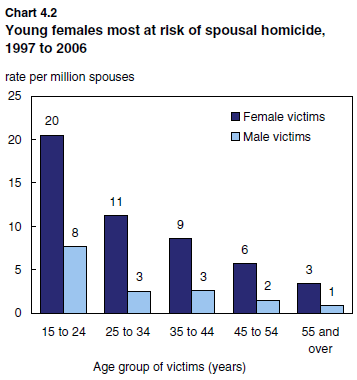
Notes: Rate per 1,000,000 legally married, common-law, separated and divorced spouses, 15 years of age and over, based on estimates
provided by Demography Division, Statistics Canada. Spousal
homicides reported by police include a small number of victims who
were separated from a common-law relationship. As population
estimates are unavailable for this sub-population, the overall rates
of spousal homicide may be slightly overestimated. Seven same-sex
partners were excluded from the analysis, due to the unavailability
of population estimates.
Source: Statistics Canada, Canadian Centre for Justice Statistics, Homicide Survey.
Most male victims of spousal homicide killed by stabbing, while female spouses were equally likely to be stabbed or shot
Methods used to kill spouses differed for male and female victims. Between 1997 and 2006, the most common method used to kill male spouses was stabbing (69%). In contrast, female victims of spousal homicide were equally likely to be stabbed or shot (30% each). A larger proportion of female spousal victims were killed as a result of physical force such as beating, strangulation, suffocation or drowning compared to males (36% of female victims versus 11% of male victims) (Table 4.4).
Over the past decade, the rate of firearm-related spousal homicides decreased by nearly 50% (1.14 per million spouses to 0.59 per million spouses). In 1996 there were 27 firearm-related spousal homicides compared to 16 in 2006 (Chart 4.3).
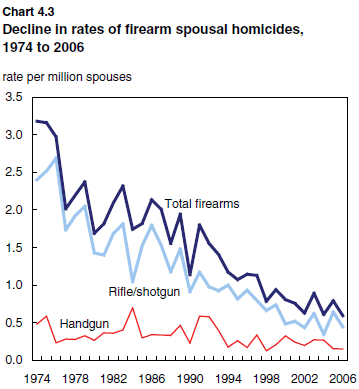
Notes: Rate per 1,000,000 legally married, common-law, separated and divorced spouses, 15 years of age and over, based on estimates
provided by Demography Division, Statistics Canada. Same-sex
partners were excluded from the analysis, due to the unavailability
of population estimates.
Source: Statistics Canada, Canadian Centre for Justice Statistics, Homicide
Survey.
Family homicides against children and youth3
In 2006, there were 60 homicides committed against children and youth under the age of 18 across Canada.
Six in 10 homicides against children and youth were committed by family members in 2006 (36 homicides), compared to 27% committed by non-family members (including acquaintances and friends) (16). The remaining 13% of child homicides (8) were unsolved.
With few exceptions, the rate of child and youth homicides perpetrated by family members has been consistently higher than the rate committed by non-family members (Chart 4.4). The family rate decreased in 2005 to just over 3 homicides per million children and youth, the lowest rate in 33 years.
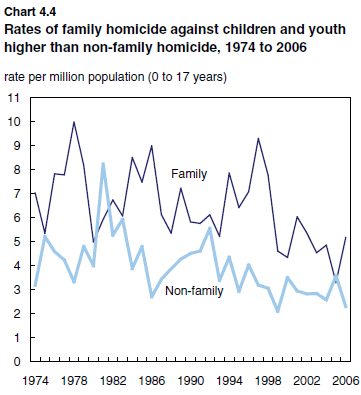
Notes: Excludes homicides for which police reported the accused-victim relationship as unknown. Rates are calculated per million children
and youth (0 to 17 year olds) using population estimates provided by
Statistics Canada, Census and Demographic Statistics, Demography
Division.
Source: Statistics Canada, Canadian Centre for Justice Statistics, Homicide
Survey.
Parents responsible for most family-related homicides against children and youth
The majority of family perpetrated homicides against children under 18 years of age are committed by parents. Over the past three decades (1977 to 2006), 90% of family-related homicide victims under the age of 18 were killed by a parent.4
Fathers are more likely than mothers to be the perpetrators (Chart 4.5). Between 1997 and 2006, 56% of children killed by a family member were killed by their fathers, 33% by their mothers, and the remaining 10% by other family members including siblings, grandparents, cousins or other extended family.5
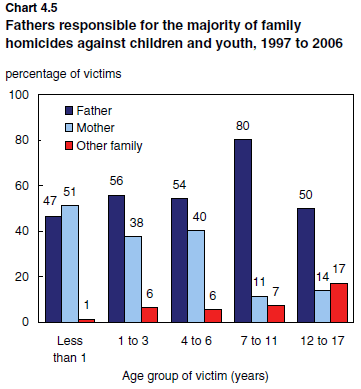
Notes: Percentages may not add up to 100% due to rounding. Based upon a subset consisting of those victims who were killed by one person,
representing 95% of the total number of family-related homicides
against children and youth from 1997 to 2006. Mothers and fathers
include biological, step, adoptive and foster parents. ‘Other family’
includes siblings, cousins and any other family member related to the
victim by blood, marriage or adoption.
Source: Statistics Canada, Canadian Centre for Justice Statistics, Homicide
Survey.
Infants are at greatest risk of homicide by a family member
Between 1997 and 2006, about one-quarter (26%) of children and youth killed by a family member were infants (under the age of one year). Baby boys tend to be at somewhat greater risk than baby girls. During the most recent 10-year period, the rate of baby boys killed by a family member averaged 35 per million male infants, compared to 27 per million female infants (Chart 4.6).

Note: Rates are calculated per million children and youth (0 to 17 year olds) according to the applicable age group and sex category using
population estimates provided by Statistics Canada, Census and
Demographic Statistics, Demography Division.
Source: Statistics Canada, Canadian Centre for Justice Statistics, Homicide
Survey.
The methods used in family-related homicides against children under the age of 18 varied depending on the age of the victim (Table 4.5). Family members who kill young children (0 to 6 years of age) are most likely to use physical force (e.g. strangulation, beating or Shaken Baby Syndrome). Older children and youth (7 to 17 years of age) are most likely to be killed with a weapon (e.g. knife or firearm).
Family homicides against older persons
Data from the Homicide survey indicate that the rate of homicide is lower among older adults compared to those under 65 years of age. This is consistent with overall police-reported crime rates which show that older Canadians are the least likely age group to be victimized.
In 2006, a total of 30 homicides were committed against seniors (18 males and 12 females). One-half of the homicides against seniors were committed by a family member, one-quarter (26%) were killed by an acquaintance, and 13% by a stranger. The remaining were unsolved.
Family-perpetrated homicides against seniors represented a relatively small proportion (2.5%) of all homicides in Canada (605) in 2006. With few exceptions, over the past three decades (1977 to 2006), the rate of family-related homicide against seniors has been lower than that of non-family perpetrated homicides (Chart 4.7).
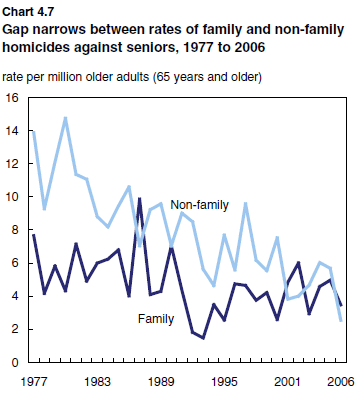
Note: Rates are calculated per million older adults (65 years and older) using population estimates provided by Statistics Canada, Census
and Demographic Statistics, Demography Division.
Source: Statistics Canada, Canadian Centre for Justice Statistics, Homicide
Survey.
Family-related homicides against older women most often committed by a spouse or adult son
Family-related homicides against older women are most commonly committed by the victim’s spouse (40%) or adult son (34%). Senior male homicide victims killed by family members are most often murdered by their adult son or step-son (61%) (Chart 4.8).
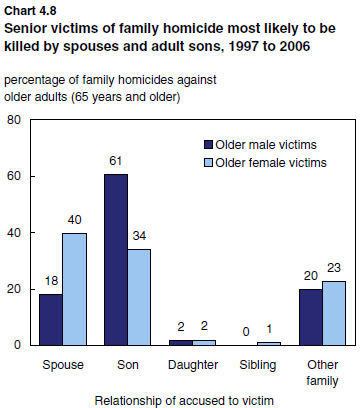
0 true zero or a value rounded to zero
Notes: Percentages may not add to 100% due to rounding. Spouse includes
legal, common-law, separated, divorced and same sex spouses. Son
and daughter includes biological, adoptive, foster and step-children.
Sibling includes biological, adoptive, foster and step-siblings. ‘Other
family’ includes grandchildren, aunts, uncles, nieces, cousins and any
other family member related by blood, marriage or adoption.
Source: Statistics Canada, Canadian Centre for Justice Statistics, Homicide
Survey.
Homicides committed by family members against older adults (65 years and older) are primarily motivated out of frustration, anger or despair (34%) followed by an argument (29%). In comparison, the most common apparent motive behind homicides committed by non-family members against senior is financial gain (34%) (Table 4.6).
____________
Endnotes
- Spousal homicides involve persons in legal marriages, those who are separated or divorced from such unions and those in common-law relationships (including same-sex spouses).
- Solved homicides refer to those where at least one accused has been identified by police.
- Throughout this section, the terms ‘children’ and ‘child’ are used interchangeably and refer to all children (biological or adopted) of the victim and includes children and youth under the age of 18. Child and youth homicides may be under-reported since some deaths caused by intentional injury may be misclassified as resulting from natural or undetermined causes.
- Includes step and adopted parents.
- Related to the victim by blood, marriage or adoption.

